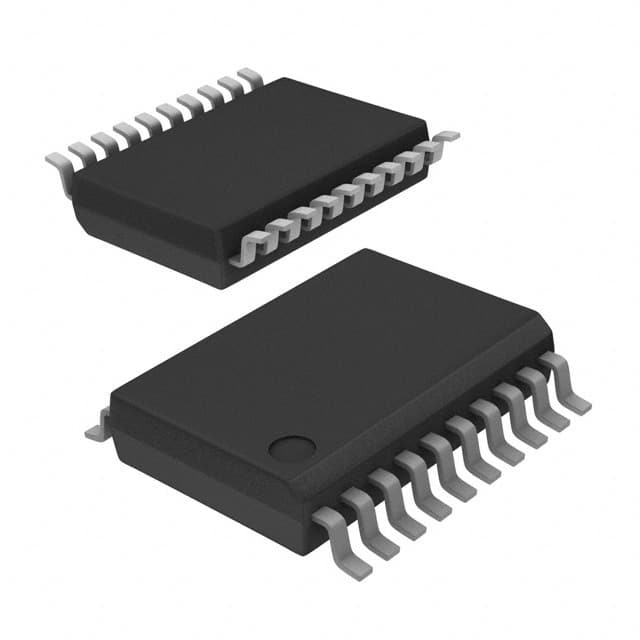PIC16C58B-04E/SS
Product Overview
Category
The PIC16C58B-04E/SS belongs to the category of microcontrollers.
Use
This microcontroller is commonly used in various electronic devices and embedded systems for controlling and processing data.
Characteristics
- Low power consumption
- High performance
- Compact size
- Versatile functionality
- Easy integration with other components
Package
The PIC16C58B-04E/SS is available in a SSOP (Shrink Small Outline Package) package.
Essence
The essence of this microcontroller lies in its ability to provide efficient control and processing capabilities in a compact form factor.
Packaging/Quantity
The PIC16C58B-04E/SS is typically packaged in reels or tubes, with a quantity of 250 units per reel/tube.
Specifications
- Architecture: 8-bit
- CPU Speed: 4 MHz
- Program Memory Size: 3.5 KB
- RAM Size: 25 bytes
- Number of I/O Pins: 12
- Timers: 1 x 8-bit, 1 x 16-bit
- ADC Channels: 5
- Communication Interfaces: SPI, USART, MSSP (Master Synchronous Serial Port)
Detailed Pin Configuration
The PIC16C58B-04E/SS has a total of 18 pins, each serving a specific purpose. The pin configuration is as follows:
- VDD - Power supply voltage
- RA0/AN0 - Analog input / Digital I/O
- RA1/AN1 - Analog input / Digital I/O
- RA2/AN2 - Analog input / Digital I/O
- RA3/AN3 - Analog input / Digital I/O
- RA4/T0CKI/C1OUT - Timer0 clock input / Digital I/O / Comparator output
- RA5/AN4/MCLR/VPP - Analog input / Master Clear input / Programming voltage
- VSS - Ground
- RB0/INT - External interrupt input / Digital I/O
- RB1/SDI/SDA - SPI data input / I2C data input / Digital I/O
- RB2/SDO/SA0 - SPI data output / I2C data output / Digital I/O
- RB3/SCK/SCL - SPI clock input / I2C clock input / Digital I/O
- RB4/T1OSO/T1CKI - Timer1 oscillator output / Timer1 clock input
- RB5/T1OSI/PGM - Timer1 oscillator input / In-Circuit Serial Programming pin
- RB6/PGC - ICSP programming clock
- RB7/PGD - ICSP programming data
- OSC1/CLKIN - Oscillator input
- OSC2/CLKOUT - Oscillator output
Functional Features
The PIC16C58B-04E/SS microcontroller offers several functional features, including:
- 8-bit CPU for efficient data processing
- Low power consumption for extended battery life
- On-chip peripherals such as timers and ADC for versatile applications
- Multiple communication interfaces for easy integration with other devices
- Flexible I/O pins for interfacing with external components
- Built-in oscillator for accurate timing operations
Advantages and Disadvantages
Advantages
- Compact size allows for space-efficient designs
- Low power consumption extends battery life in portable devices
- Versatile functionality enables a wide range of applications
- Easy integration with other components simplifies system design
- Cost-effective solution for embedded systems
Disadvantages
- Limited program memory size may restrict complex applications
- Limited RAM size may pose challenges for data-intensive tasks
- Lower clock speed compared to some other microcontrollers may affect performance in certain applications
Working Principles
The PIC16C58B-04E/SS operates based on the Von Neumann architecture, where it fetches instructions from program memory and executes them sequentially. It utilizes a Harvard architecture, allowing simultaneous access to program memory and data memory. The microcontroller follows a single-cycle execution model, where each instruction is executed in a single clock cycle.
Detailed Application Field Plans
The PIC16C58B-04E/SS finds applications in various fields, including:
- Industrial Automation: Control systems, monitoring devices, and sensors.
- Consumer Electronics: Remote controls, smart home devices, and wearable technology.
- Automotive: Engine control units, dashboard displays, and vehicle diagnostics.
- Medical Devices: Patient monitoring systems, medical instruments, and diagnostic equipment.
- Internet of Things (IoT): Connected devices, smart appliances, and environmental sensors.
Detailed and Complete Alternative Models
- PIC16F628A
Lista 10 Vanliga frågor och svar relaterade till tillämpningen av PIC16C58B-04E/SS i tekniska lösningar
What is the operating voltage range of PIC16C58B-04E/SS?
- The operating voltage range of PIC16C58B-04E/SS is 2.5V to 6.0V.What are the key features of PIC16C58B-04E/SS?
- Some key features of PIC16C58B-04E/SS include 12-bit core instruction set, 14-bit wide instructions, and 33 I/O pins.Can PIC16C58B-04E/SS be used in automotive applications?
- Yes, PIC16C58B-04E/SS is suitable for automotive applications due to its wide operating voltage range and robust design.What programming language can be used to program PIC16C58B-04E/SS?
- PIC16C58B-04E/SS can be programmed using assembly language or high-level languages such as C.Is PIC16C58B-04E/SS suitable for battery-powered devices?
- Yes, PIC16C58B-04E/SS is suitable for battery-powered devices due to its low power consumption and wide operating voltage range.What communication interfaces does PIC16C58B-04E/SS support?
- PIC16C58B-04E/SS supports serial communication interfaces such as UART, SPI, and I2C.Can PIC16C58B-04E/SS be used in industrial control systems?
- Yes, PIC16C58B-04E/SS is suitable for industrial control systems due to its robust design and wide operating temperature range.What development tools are available for PIC16C58B-04E/SS?
- Development tools such as MPLAB X IDE and MPLAB XC compilers are available for programming and debugging PIC16C58B-04E/SS.Does PIC16C58B-04E/SS have built-in analog-to-digital converters (ADC)?
- Yes, PIC16C58B-04E/SS has built-in 10-bit ADC modules for analog signal processing.Can PIC16C58B-04E/SS be used in consumer electronics?
- Yes, PIC16C58B-04E/SS is suitable for consumer electronics applications such as home automation and IoT devices due to its versatile features and low power consumption.


